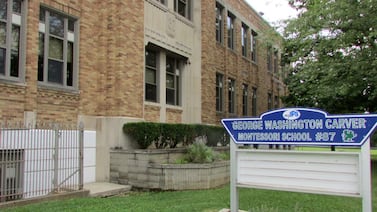Illinois hopes a new pilot program to recruit future teachers of color will help lead to the hiring of more educators of color and diversify the state’s teaching ranks, which are disproportionately white.
The state board of education announced on Thursday that 24 Illinois colleges and universities have volunteered to develop plans to recruit and retain future teachers of color. The pilot will help the board create best practices for 54 of the state’s teacher prep programs to develop plans the following year. The initiative is a part of the board’s three-year strategic plan, which includes increasing teacher diversity.
“All students, and especially students of color, benefit from having diverse educators throughout their school experiences,” said State Superintendent Carmen Ayala. “When the role models and people in positions of authority in our lives look like us, that shapes our perception of our place in the world in a positive and powerful way.”
The state’s recently released 2021 report card showed a slight uptick in the number of teachers of color hired last school year, with an increase of 1,251 Hispanic teachers and 184 Black teachers. However, 82% of teachers in the state are white — roughly the same number since 2010 — while the state’s student population is only 47% white. Studies show that teachers of color increase the academic performance of students of color, with significant increases in test scores, graduate rates, and college success rates.
At its monthly meeting on Thursday, the state school board also weighed how to get more student teachers of color to pass the state’s licensure exams.
The state board listened to a presentation by the National Center for Teacher Quality (NCTQ) — a nonprofit that researches teacher quality and is examining elementary content teacher licensure exams to see where teacher candidates leave the pipeline.
The report, titled “Driven by Data: Using licensure tests to build a strong, diverse teacher workforce,” looked at tests in 43 states including Illinois. While there are critiques of teacher licensure tests, Hannah Putman, managing director of research at NCTQ, says licensure tests are the best way to ensure that teachers know the content that they are going to teach.
For this study, researchers looked at best-attempt rates — the number of students who pass regardless of the number of times they took the test; first-pass rates — important because they shows how effective teacher prep programs are in training teachers; and walk-away rates — the proportion of students who fail on their first attempt and do not retake the test within three years.
In Illinois, teacher candidates must take the Illinois Licensure Testing System. All candidates must pass the test before earning an elementary teaching license. Data shows that the average best-attempt pass rate in Illinois is 94%, with institutions ranging from 80% to 100%. On the first attempt, 70% of test-takers pass the exam.
Currently, Illinois does not publish walk-away rates. According to national data NCTQ was able to collect from states that reported it, 22% of people who failed on the first attempt did not retake it. Nearly one in three test-takers of color did not retake the test within three years.
“We are losing a lot of teachers at this initial failure point,” said Putman. “That can be a really powerful metric to help identify where to better support people in entering the classroom.”
There has been some criticism of teacher licensure tests, with critics who say that the test is a barrier to getting more teachers of color into the pipeline and doesn’t measure the effectiveness of teachers.
In response to NCTQ’s presentation, Cynthia Riseman, legislative director at Illinois Federation of Teachers, one of the state’s largest teacher unions, said the organization relies on teacher licensure tests to tell a full story of teacher quality.
“A narrow approach that ignores the complexities of a public education system that hasn’t escaped or atone for its roots of segregation, underfunding, and disparities in opportunities and access for Black and brown students and teacher candidates,” said Riseman.
In addition to studying what the state’s institutions of higher education can do to increase potential students of color, some board members are looking at historically Black colleges and universities for answers.
Donna Leak, board members and superintendent of Community Consolidated Schools District 168, asked Putman if NCTQ would look at the pass rate for students at historically Black institutions. Putman said that she plans to look into minority-serving institutions in their national data set.
“We talk about African American children and children of color having teachers of color,” Leak said, “but it really comes down to whether all children need to see a teacher of color at some point in their academic career.”







